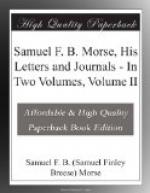“The reflections which this melancholy contrast caused I could not help communicating to Mr. Putnam in the words of Mr. Spring’s sermon, ‘something must be done.’ He agreed it was a dreadful state of society here but almost gave up as hopeless. I told him he never should yield a post like this to the Devil without a struggle; and, at any rate, I told him that the few Christians that there were (and, indeed, they are but as one to one thousand) could pray, and I thought it was high time. I told him I would do all in my power to assist him in any scheme where I could be of use.”
The year 1817 was spent by the young man in executing the commissions which had been promised him the year before in New Hampshire. In all his journeyings back and forth the road invariably led through Concord, and the pure love of the young people for each other increased as the months rolled by. I shall not profane the sacredness of this love by introducing any of the more intimate passages of their letters of this and of later years. The young girl responded readily to the religious exhortations of her fiance and became a sincere and devout Christian.
It will not be necessary to follow him in this journey, as the experiences were but a repetition of those of the year before. He painted many portraits in Concord, Hanover, and other places, and finally concluded to venture on a trip to Charleston, South Carolina, where his kinsman, Dr. Finley, and Mr. John A. Alston had urged him to come, assuring him good business.
On January 27, 1818, he arrived in that beautiful Southern city and thus announced his arrival to his parents: “I find myself in a new climate, the weather warm as our May. I have been introduced to a number of friends. I think my prospects are favorable.”
At first, however, the promised success did not materialize, and it was not until after many weeks of waiting that the tide turned. But it did turn, for an excellent portrait of Dr. Finley, one of the best ever painted by Morse, aroused the enthusiasm of the Charlestonians, and orders began to pour in, so that in a few weeks he was engaged to paint one hundred and fifty portraits at sixty dollars each. Quite an advance over the meagre fifteen dollars he had received in New England. But for some of his more elaborate productions he received even more, as the following extract from a letter of Mr. John A. Alston, dated April 7, 1818, will prove:—
“I have just received your favor of the 30th ultimo, and thank you very cordially for your goodness in consenting to take my daughter’s full-length likeness in the manner I described, say twenty-four inches in length. I will pay you most willingly the two hundred dollars you require for it, and will consider myself a gainer by the bargain. I shall expect you to decorate this picture with the most superb landscape you are capable of designing, and that you will produce a masterpiece of painting. I agree to your taking it with you to the northward to finish it. Be pleased to represent my daughter in the finest attitude you can conceive.”




